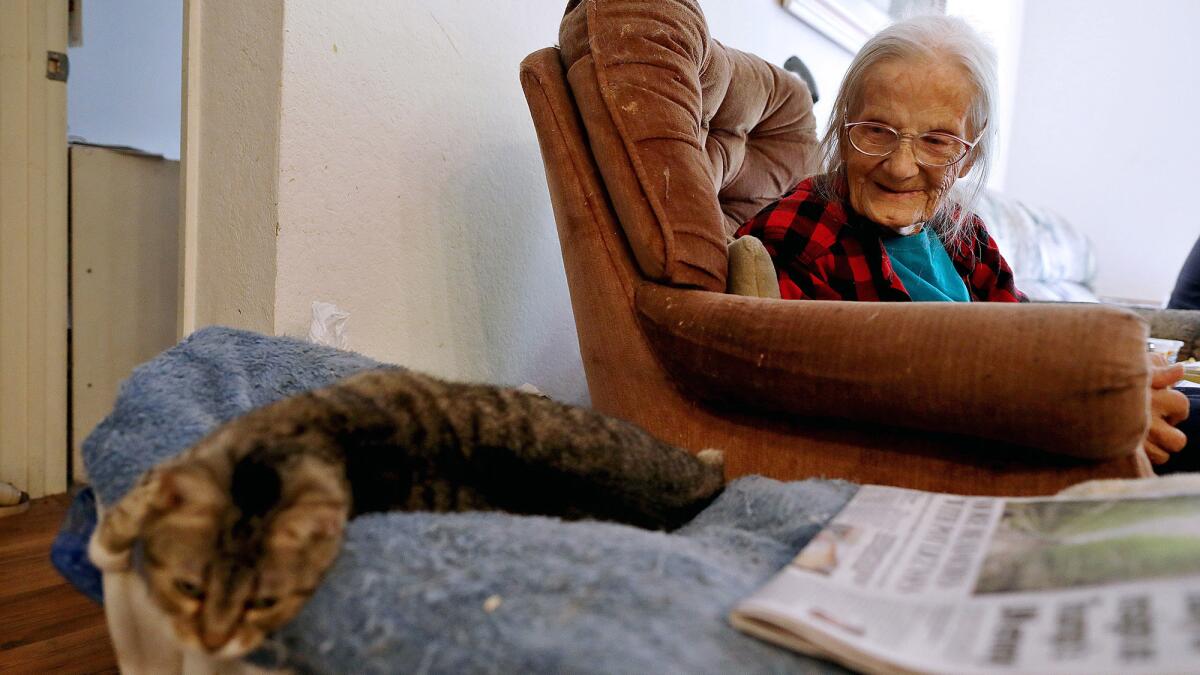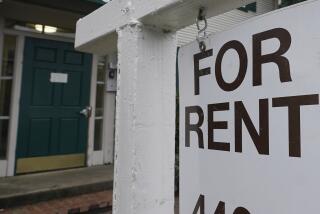Housing vouchers can save people from homelessness. But landlords may not accept them

When Kimberly Dominique received her Section 8 voucher in September, she thought it was the ticket to move out of the Ford Focus she and her 29-year-old son called home.
But Dominique, a 66-year-old stroke survivor, spent months contacting one apartment complex after another in Oceanside, only to have landlords reject the voucher, which can provide hundreds of dollars toward a rent payment.
One day, Dominique estimated, she called more than 70 landlords. Those who answered or bothered to call back all had the same answer: No.
“It’s taken its toll,” Dominique said late last year, noting that she’d lost weight and grown increasingly depressed as her voucher neared expiration.
“Sometimes, I feel like I’m losing hope,” said Dominique’s son, Dion.
In California, more than half of tenants struggle with unaffordable rent. Tens of thousands bed down on the streets at night. Vouchers are one of the federal government’s most powerful weapons to fight both problems, but low-income households can wait more than 10 years just to get one — and, increasingly, they can’t find a landlord willing to take it.
Experts say landlords have a variety of reasons for resisting, including concerns over red tape. But the largest one is simple economics: Property owners increasingly can charge more than the government is willing to pay.
Government data used to calculate subsidy caps are out of date and unlikely to reflect sharp upswings in markets like Southern California, experts say, and too little housing is built in coastal California relative to job and population growth, so landlords can command eye-popping figures.
Zillow data show median rent for a two-bedroom unit in L.A. County has soared 56% since 2012, to $2,700 in February. The federally approved “fair market rent,” meanwhile, rose 23.8%, to $1,791.
“The payment standard is always trailing the actual market,” said Roberto Chavez, housing supervisor for the city of Redondo Beach. “If [I’m a landlord] … and putting a sign out for $5,000 and I get it, that’s the new market.”
According to the latest available data, just under half the people who received a voucher in the city of Los Angeles had it expire in 2017 before they found a place, up from 18% in 2011.
Expirations are also on the rise in unincorporated areas and cities that don’t have their own authority, such as Whittier, Huntington Park and Lancaster, according to the Housing Authority of the County of Los Angeles.
“Right off the bat, landlords won’t work with us,” said Carlos Van Natter, the Section 8 director for the Housing Authority of the City of L.A. “Over time, the geographic areas we can work in the city has shrunk to the poorest neighborhoods.”
Mary Wiley, a 53-year-old bookkeeper, is living with an ex-boyfriend while trying to secure a unit in Pasadena, but has repeatedly found rents are too high or landlords outright won’t accept a voucher. She may have found one unit, but is now waiting to see whether the city will approve it.
“It’s been really hard,” she said. “[Landlords]don’t want Section 8.”
The program, which gets its name from a section of the federal Housing Act, is administered through local housing agencies that receive U.S. Housing and Urban Development funds. It was launched in the 1970s as an alternative to costly public housing projects, which were criticized for segregating poor families in neighborhoods with low-quality schools.
Unlike public housing, the federal subsidy under Section 8 moves with tenants so they can find housing with private landlords.
About 2.2 million low-income households nationwide have vouchers. By one estimate 17 million more would qualify but don’t get subsidies because of budget limitations.
Individual subsidy caps are calculated using what HUD deems fair market for a metro area. Based on the fair market rent for Los Angeles County, for instance, tenants with a coveted voucher could rent a two-bedroom at or below $1,791. They then typically pay 30% of their income toward rent, with the local public housing agency making up the difference.
A tenant could rent something above the cap, but only if their portion of rent doesn’t exceed 40% of their income — a limitation that is made more difficult because the government doesn’t increase its subsidy to reflect higher rents.
HUD generally aims to set its fair market rents at the 40th percentile of metro rents, so in theory the bottom 40% of the market should qualify. But only 10% of Craigslist listings for L.A County this year were at or below HUD’s fair market rent, according to an analysis by UC Berkeley professor Paul Waddell and doctoral student Aksel Olsen. A recent Zillow analysis had similar findings.
A HUD spokesman said the agency views the government survey it uses to calculate fair market rents as the most comprehensive data available and noted individual public housing agencies have several options to increase subsidies and rent caps above the fair market levels. Flexibility is limited, though.
In the city of Los Angeles, which has raised its cap for a two-bedroom to $1,970, most voucher holders live in South L.A. or other low-income neighborhoods. The listing site the city works with, GoSection8.com, shows swaths of wealthy neighborhoods with few to no advertised rentals.
The tight market is also making more difficult a local effort to house homeless individuals with vouchers. And while rents have cooled somewhat recently, apartment buildings that are bought and then upgraded threaten to add to the ranks of people without a home. Chavez said investors are scooping up Redondo Beach properties, for instance, and booting Section 8 tenants to charge more.
With much of coastal California out of reach, some people head east.

Last May, Janet Knoy, 85, received what she felt was an unfair eviction notice from her Anaheim apartment community. A manager there said the notice wasn’t a pretext to bring in a higher-paying tenant. But to find a landlord who would accept her voucher, Knoy and her caregiver moved 100 miles away to Desert Hot Springs.
“We wanted to find a place in Orange County,” said Gregory Dobalian, her caregiver. “I called a hundred places.”
But even when a home meets the rent caps, many landlords still reject voucher holders. Across Los Angeles County, a recent Urban Institute study found, 76% of landlords with units below payment standards turned down vouchers.
Part of the trouble, housing advocates say, is many landlords believe voucher holders are bad tenants — a belief that advocates say is inaccurate and can reflect racist views of black households, which account for a plurality of people using Section 8 nationwide.
“They don’t want to rent to African Americans,” said Wiley, the Pasadena voucher holder, who believes her race has made it more difficult to find a place.
In a 2009 study of 100 properties, the Greater New Orleans Fair Housing Action Center found most landlords refused to take Section 8. But in 9% of those rejections a landlord, citing the voucher, had denied a black tester with the same or higher income as a white tester, even though the landlord previously told the white tester that vouchers were accepted.
The L.A. County Housing Authority and the cities of Lancaster and Palmdale in 2015 settled a case in which the U.S. Department of Justice alleged that “racially based public opposition” drove the Antelope Valley cities to work with the county and sheriff’s deputies to drive out black Section 8 tenants. The authority and cities admitted no wrongdoing.
“There are a lot of stereotypes that are tied into landlord concern,” said Morgan Williams, general counsel for the National Fair Housing Alliance. “At times, discrimination against a household with a voucher is used as a proxy for discrimination on the basis of race.”
Landlords, meanwhile, complain about red tape. Janet Gagnon, government affairs director for the Apartment Assn. of Greater Los Angeles, said many L.A. landlords are willing to accept Section 8 vouchers, but the city’s housing authority, known as HACLA, makes it increasingly difficult.
To an extent greater than other cities, she said, her mom-and-pop members in L.A. have complained about delayed housing inspections, delayed first month’s rent and lack of help with problem tenants, issues they say have worsened over the years. Since 2014, the number of landlords working with HACLA has fallen 7%.
“There seems like there is some sort of customer service problem at HACLA,” Gagnon said. “They want people to use Section 8, but they don’t want to help them do it.”
Van Natter, the agency’s Section 8 head, said that staff cuts have made customer service more challenging, but that the agency is working to improve and that most clients are satisfied.
Anne Lansing, housing assistance officer with the city of Pasadena, said government red tape is less of an issue in a down market, when landlords are more willing to wait to get a guaranteed payment from the government.
“When the market is strong like it is now, they become much less friendly,” she said.
James Stracner, HUD’s Pacific regional administrator, says federal authorities “recognize there is a problem.” HUD recently completed a listening tour with landlords and is compiling a list of policy changes for Secretary Ben Carson, some of which may require congressional approval.
In Los Angeles, city officials are debating whether to ask HUD to set payment standards by neighborhood instead of citywide. And they are mulling over a “source of income” ordinance to prohibit landlords from instituting blanket bans on Section 8 tenants. Santa Monica, San Diego and some states have already passed those laws. In January, the L.A. County Board of Supervisors voted to draft such an ordinance to cover unincorporated areas and a state-wide bill is pending in the legislature.
Those rules don’t stop landlords from rejecting a Section 8 tenant who can’t pay a higher rent. But they do prohibit landlords from rejecting tenants simply because they use vouchers, and they outlaw common advertisements that say things like “No Section 8” or “No vouchers.”
Research has shown voucher denial rates are lower where the laws exist. Sen. Tim Kaine (D-Va.) and then-Sen. Orrin G. Hatch (R-Utah) introduced a bill in the last Congress to institute a federal version, but it never came up for a vote.
Even if such a law passed, advocates worry the federal government stands to worsen the problem in other ways. The partial government shutdown in December and January threw subsidy checks into doubt. And the Trump administration, in its proposed 2020 budget, is seeking to cut funding for existing vouchers by 1%, which equates to 6% when adjusting for factors such as rent inflation, according to the Center on Budget and Policy Priorities.
Meanwhile, for low-income renters, the search goes on.
After Kimberly Dominique got her voucher in September, she and her son were surprised they didn’t quickly move off the streets.
In between searches Dominique, whose health problems have kept her from working, would go to the park or the beach. Dion drove for Uber or Lyft to scrape together cash. They would sleep in their car or in shelters, occasionally having run-ins with police who told them to move along.
“I am not a criminal,” Dominique said, “but you feel like one.”
In late January, after four months of looking, they finally found a landlord in Irvine who accepted their voucher.
Times staff writer Ellis Simani contributed to this report.
Follow me @khouriandrew on Twitter
More to Read
Inside the business of entertainment
The Wide Shot brings you news, analysis and insights on everything from streaming wars to production — and what it all means for the future.
You may occasionally receive promotional content from the Los Angeles Times.











